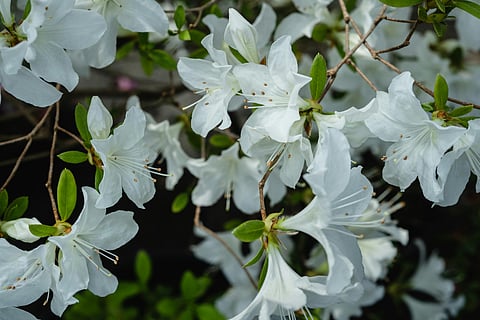
- LIFESTYLE
- FASHION
- FOOD
- ENTERTAINMENT
- EVENTS
- CULTURE
- VIDEOS
- WEB STORIES
- GALLERIES
- GADGETS
- CAR & BIKE
- SOCIETY
- TRAVEL
- NORTH EAST
- INDULGE CONNECT

The rhododendron flower, known for its vibrant colours and stunning blooms, is more than just a beautiful plant; it plays a significant role in various cultures and traditions, particularly in regions where it thrives, such as the Himalayas and parts of East Asia. Among its many uses, one of the most intriguing is the tea made from its flowers, celebrated for its unique flavour and potential health benefits.
Rhododendrons belong to the Ericaceae family and are characterised by their large, bell-shaped flowers that come in shades of pink, red, purple, and white. The plant is predominantly found in mountainous regions, where it flourishes in acidic soils and cooler climates. While many species of rhododendron exist, not all are suitable for consumption. The most commonly used for tea is the Rhododendron arboreum, which is native to the Himalayan region and is known locally as Buransh in Hindi.
The preparation of rhododendron tea involves harvesting the flowers, which are typically collected in the spring. The petals are then dried, preserving their vibrant colours and delicate flavours. When brewed, the tea offers a light, floral taste with subtle hints of sweetness and tartness, reminiscent of a gentle fruit infusion. It can be enjoyed hot or cold, often sweetened with honey or enjoyed plain to savour its natural flavour.
Rhododendron tea is not only appreciated for its taste but also for its potential health benefits. Traditionally, it has been used in folk medicine to treat various ailments, including respiratory issues, inflammation, and digestive problems. The flowers are rich in antioxidants, which can help combat oxidative stress in the body. Additionally, some studies suggest that compounds found in rhododendron may have antimicrobial properties, contributing to overall wellness.
In addition to its medicinal uses, rhododendron tea has cultural significance in many communities. In the Himalayas, for instance, it is often served during festivals and family gatherings, symbolizing hospitality and warmth. The vibrant flowers are also associated with various myths and legends, adding to their allure and cultural richness.
However, it is important to note that not all rhododendron species are safe for consumption. Some contain toxins that can lead to adverse effects if ingested. Therefore, it is crucial to ensure that the flowers are sourced from a safe and reliable variety.